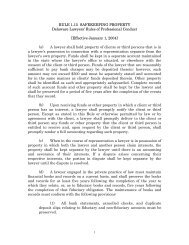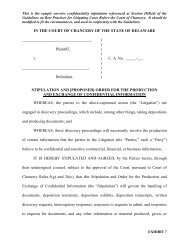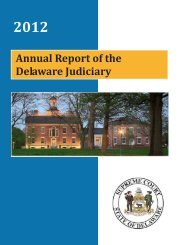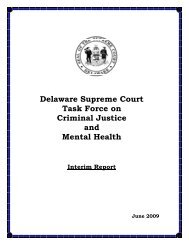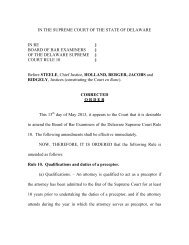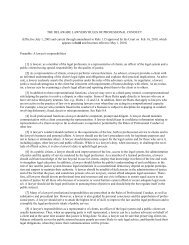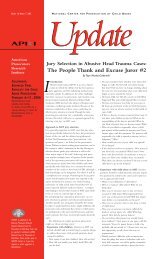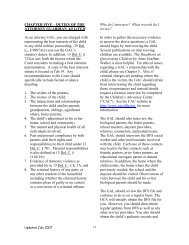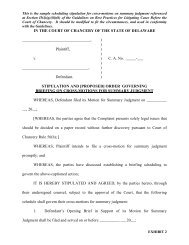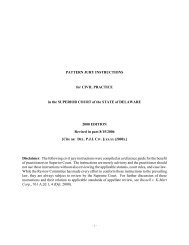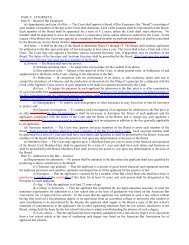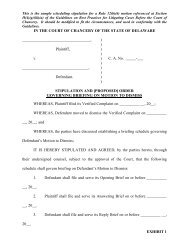Uniform Citation (DE) - Delaware State Courts - State of Delaware
Uniform Citation (DE) - Delaware State Courts - State of Delaware
Uniform Citation (DE) - Delaware State Courts - State of Delaware
- No tags were found...
Create successful ePaper yourself
Turn your PDF publications into a flip-book with our unique Google optimized e-Paper software.
Introduction................................................................................ 1(a) General purpose <strong>of</strong> citation: Why it matters..................... 1(b) How to use <strong>Delaware</strong> <strong>Uniform</strong> <strong>Citation</strong>........................... 4Rule 1 Structure and use <strong>of</strong> citations ..................................... 61.1 <strong>Delaware</strong> citation rules.................................................. 6(a) Old <strong>Delaware</strong>-style case citations .................................... 71.2 <strong>Citation</strong> placement ........................................................ 81.3 <strong>Citation</strong> order.............................................................. 11Rule 2 Typefaces .................................................................. 13Rule 3 Subdivisions.............................................................. 15(a) Pinciting in sections....................................................... 15(b) Citing specific pages with a range ................................. 16Rule 4 Short citation forms ................................................. 16Rule 5 Quotations ................................................................ 175.1 <strong>Citation</strong>s and footnotes omitted................................... 175.2 Indicating alterations, omissions, andemphases (indicative parentheticals) ........................... 19(a) Ordering indicative parentheticals.................................. 19(b) Internal quotation marks................................................ 195.3 Placement <strong>of</strong> indicative parentheticals......................... 21Rule 6 Abbreviations, numerals, and symbols ................... 22Rule 7 Italicization............................................................... 23Rule 8 Capitalization ........................................................... 23Rule 9 Titles ......................................................................... 23Rule 10 Cases ...................................................................... 2410.1 General rules............................................................... 2410.2 Published cases ........................................................... 26(a) Supreme Court cases ..................................................... 26(b) Superior Court cases...................................................... 27(c) Court <strong>of</strong> Chancery cases ................................................ 28(d) Family Court cases........................................................ 29(e) Court <strong>of</strong> Common Pleas cases ....................................... 29ii
(f) Justice <strong>of</strong> the Peace cases ............................................... 30(g) Court on the Judiciary cases .......................................... 30(h) Cases from historical <strong>Delaware</strong> courts........................... 3010.3 Unpublished cases....................................................... 32(a) Online databases............................................................ 33(b) Memorandum and letter opinions .................................. 35(c) Journals ......................................................................... 36(d) Table opinions............................................................... 36(e) Transcripts and bench rulings ........................................ 3710.4 Orders......................................................................... 3710.5 Administrative directives ............................................ 3810.6 Short forms ................................................................. 39Rule 11 Constitutions.......................................................... 40(a) Current Constitution ...................................................... 40(b) Previous Constitutions................................................... 40(c) Constitutional debates.................................................... 41(d) Short forms ................................................................... 41Rule 12 Statutes .................................................................. 4212.1 <strong>Delaware</strong> Code............................................................ 42(a) Current codifications ..................................................... 42(b) Past codifications .......................................................... 4312.2 Laws <strong>of</strong> <strong>Delaware</strong> ....................................................... 44(a) <strong>Citation</strong> formats............................................................. 44(b) Indicating enactment, amendment, or repeal.................. 4512.3 Rules <strong>of</strong> evidence and procedure................................. 46(a) <strong>Delaware</strong> Rules <strong>of</strong> Evidence .......................................... 46(b) <strong>Delaware</strong> rules <strong>of</strong> procedure.......................................... 46(c) Jury instructions ............................................................ 4812.4 Rules <strong>of</strong> pr<strong>of</strong>essional responsibility(and ethics opinions) ................................................... 4812.5 Municipal codes, charters, and ordinances................... 49(a) County codes................................................................. 49(b) City and town codes ...................................................... 50(c) Municipal charters......................................................... 51iii
(d) Ordinances .................................................................... 5112.6 Short forms ................................................................. 52Rule 13 Legislative materials ............................................. 5313.1 Bills and resolutions.................................................... 5313.2 Debates and proceedings............................................. 5413.3 Joint Sunset Committee reports................................... 5413.4 Short forms ................................................................. 55Rule 14 Administrative and executive materials ............... 5614.1 Regulations ................................................................. 56(a) <strong>Delaware</strong> Administrative Code...................................... 56(b) <strong>Delaware</strong> Register <strong>of</strong> Regulations.................................. 5814.2 Administrative adjudications....................................... 5914.3 Executive orders and proclamations ............................ 6014.4 Attorney General opinions .......................................... 6114.5 Short forms ................................................................. 62Rule 15 Books and other nonperiodic materials................ 64Rule 16 Periodical materials............................................... 66(a) Law journals.................................................................. 66(b) Newspapers, magazines, and other periodicals............... 68Rule 17 Unpublished and forthcoming sources ................. 70Rule 18 Electronic media and other nonprint resources... 70Rule 19 Services .................................................................. 70Rule 20 Foreign materials .................................................. 70Rule 21 International materials ......................................... 70Rule 22 Other materials ..................................................... 71(a) Contracts and similar documents ................................... 71(b) Court documents ........................................................... 72Table <strong>of</strong> abbreviations.............................................................. 73iv
Introduction(a) General purpose <strong>of</strong> citation: Why it mattersJust about everyone in the legal community dislikes theemphasis placed on citation form. The Bluebook is seen as an obsessionfor neurotic law-review editors. Lawyers, judges, and pr<strong>of</strong>essors allgrumble about its vagaries: it’s too long and too complicated and toopedantic. (Law-review editors know that The Bluebook is, in fact, notlong enough—the wide variety and complexity <strong>of</strong> available sources faroutstrip the 21 Bluebook rules.) Competing citation manuals haveappeared, challenging The Bluebook by attempting simplicity. For themost part, though, citation form is politely ignored, left for paralegals,first-year associates, law clerks, or those suffering law-review editors.But citation form matters.Legal citation’s most important function is “to allow the readerto efficiently locate the cited source.” 1 Proper citations give readers animmediate sense <strong>of</strong> the strength, relevance, and authoritativeness <strong>of</strong> asource. <strong>Citation</strong>s help readers find a source, as well as the specificauthority within the source that supports or contradicts the propositionmade. Good citations deliver this information with economy, usingabbreviations and structural formats to convey the necessary informationwith a minimum <strong>of</strong> space. <strong>Citation</strong> form, while providing a commoneds., 18th ed. 2005).11 The Bluebook: A <strong>Uniform</strong> System <strong>of</strong> <strong>Citation</strong> 2 (Columbia Law Review Ass’n et al.
language for the legal community, also subtly signals a lawyer’s care andcompetence.Good citations are efficient. For example, “506 A.2d 173, 184n.16 (Del. 1986)” alone conveys at least the following: The sourcereferred to is a case, decided by the <strong>Delaware</strong> Supreme Court in 1986.That case can be found in the second edition <strong>of</strong> the Atlantic Reporter. Itstarts on page 173 <strong>of</strong> volume 506 in that series. The specific authoritycan be found in footnote 16, which begins on page 184 <strong>of</strong> the Court’ssole or majority opinion. All this in 28 characters!<strong>Citation</strong>s can reveal more subtle source characteristics as well.For example, aside from the obvious, a reader can immediately discernthat “13 Am. Bankr. Inst. L. Rev. 1 (2007)” refers to a periodical thatcomes out in multiple issues per year and has consecutive pagination(that is, issue 1 ran from pages 1 to 416, and issue 2 started at page 417).On the other hand, “Am. Bankr. Inst. J., Mar. 2007, at 1” refers to aperiodical with pages that start over at 1 in each issue. To find the secondsource, you need to find the issue for the right month and year, becausethere could be as many as twelve page 1’s in 2007. The first source,however, only has a single page 1 in all <strong>of</strong> 2007. Such information isuseful when rummaging around in a library.<strong>Uniform</strong> citation standards provide a common language for thelegal community. Lawyers, judges, and pr<strong>of</strong>essors use citations everyday to make and support their arguments. <strong>Citation</strong>s allow adversaries tobattle back and forth while agreeing on which authorities are disputedand where they can be found. Lawyers can call out the relative strength2
<strong>of</strong> a supporting authority with “See” or “Cf.”—or by omitting the signalaltogether; other lawyers can understand this immediately.Proper citation form helps establish a writer’s credibility andcompetence. At least one commentator has mentioned the reputationalimportance <strong>of</strong> citation form. For example, “[n]othing exposes thesecond-rate lawyer more quickly than an obvious error in citation form.” 2Others have similar opinions. Bryan Garner notes that “incorrectcitations can impair a writer’s credibility and call an argument’s validityinto question—they may even lead to sanctions.” 3 He also reveals thebehind-the-scenes truth about why Bluebook form matters:So who cares [about citation form]? Don’t forgetthat the initial reader <strong>of</strong> your brief is <strong>of</strong>ten a law clerk,not a judge. And who are law clerks? Usually, formerlaw-review editors—and recent ones, at that. And whatdo former law-review editors, especially recent ones,have in common? A Bluebook fetish.You get the idea. 4<strong>Citation</strong> form is the infrastructure <strong>of</strong> legal writing, taken forgranted when done well and reviled when it causes problems. But—likeany infrastructure—it is vital to the larger enterprise. Fortunately forpractitioners, it’s really not that hard: once you can cite cases, statutes,books, and law journals, you’re nearly all the way there. Lawyers don’tneed to know everything; they just need to know how to find it. For2 Irwin Alterman, Plain and Accurate Style in Court Papers § 7.09, at 116 (1987).3 Bryan A. Garner, The Redbook: A Manual on Legal Style § 8.1, at 105 (2002).4 Bryan A. Garner, The Winning Brief: 100 Tips for Persuasive Briefing in Trial andAppellate <strong>Courts</strong> 359 (2d ed. 2004).
citation form, you don’t have to know how to cite everything, just how t<strong>of</strong>ind out. That’s why The Bluebook exists, and that’s why <strong>Delaware</strong><strong>Uniform</strong> <strong>Citation</strong> exists.(b) How to use <strong>Delaware</strong> <strong>Uniform</strong> <strong>Citation</strong>The Bluebook amply handles most citation issues. TheBluepages, the light-blue pages at the front <strong>of</strong> the 18th edition <strong>of</strong> TheBluebook, are especially helpful for practicing lawyers, judges, and lawstudents. But <strong>Delaware</strong> has developed its own forms, and TheBluebook—comprehensive and long as it is—lacks several <strong>Delaware</strong>specificcitation formats. For example, The Bluebook requires citations inthe form <strong>of</strong> “Del. Code Ann. tit. 8, § 141(e) (2007)”, while most <strong>Delaware</strong>lawyers and judges would write “8 Del. C. § 141(e).”<strong>Delaware</strong> is a small state, but it looms large in the law. Itsjudicial system consistently ranks at the top nationally for judicialfairness and competence. <strong>Delaware</strong> is home to many <strong>of</strong> the country’scorporations, including most <strong>of</strong> the Fortune 1000. Lawyers from<strong>Delaware</strong> and other jurisdictions need a common language for theirspecific citation needs. <strong>Delaware</strong> <strong>Uniform</strong> <strong>Citation</strong> (DUC) attempts toprovide that common language. (<strong>Delaware</strong> law reviews can use thesecitation formats as well, taking into account the differences betweenformats for law reviews and for legal documents.)This citation manual generally follows the 18th edition <strong>of</strong> TheBluebook. (When referring to a specific rule in The Bluebook, DUC willuse the following format: Bluebook R. 10.4(a).) It also provides4
<strong>Delaware</strong>-specific citation formats and information that may conflictwith or supplement The Bluebook. The information in DUC controlswhere it conflicts with The Bluebook. For ease <strong>of</strong> use, DUC follows theRule layout <strong>of</strong> The Bluebook. Thus, just as Rule 10 in The Bluebookgoverns citation formats for cases, rule 10 in DUC governs citationformats for cases—although the subrules (rule 10.1, etc.) do notcorrelate to the subrules in The Bluebook. This means, however, thatsome rules in DUC are blank. <strong>Delaware</strong> has no need for <strong>Delaware</strong>specificcitation formats for foreign or international materials, forexample. DUC accordingly contains no information corresponding tothose Rules.The citation formats in DUC derive from the principles in TheBluebook, but they differ where <strong>Delaware</strong>’s sources are unique. Where<strong>Delaware</strong>-specific forms are necessary, such forms are created withconsideration <strong>of</strong> history, logic, and consistency. These forms are inspiredby the sources themselves or, in many cases, by citations used in theopinions <strong>of</strong> the <strong>Delaware</strong> courts. In at least one instance, the decisionsimply came down to usage patterns: the abbreviation for the Court <strong>of</strong>Chancery Rules is given in judicial opinions as both “Ct. Ch. R.” and“Ch. Ct. R.”, but the former is used twice as <strong>of</strong>ten, so it is adopted here.5
Rule 1Structure and use <strong>of</strong> citations1.1 <strong>Delaware</strong> citation rulesThe <strong>Delaware</strong> courts have issued rules regarding proper citationform for documents filed in those courts. In some courts, those rulesrequire Bluebook citation formats, for cases as well as for otherauthorities. In others, the old “<strong>Delaware</strong> style” <strong>of</strong> citation is required forcase citations. For example, the Chancery Court Rules require that<strong>Delaware</strong> cases be cited in the old <strong>Delaware</strong> style (“Melson v. Allman,Del. Supr., 244 A.2d 85 (1968).”). 5 But few practitioners follow this oldstyle <strong>of</strong> citation, while Chancery itself <strong>of</strong>ten does not.DUC largely conforms to the citation requirements for the<strong>Delaware</strong> courts (with the exception <strong>of</strong> citations to the <strong>Delaware</strong> Code).The rules not followed are noted below.· Supreme Court: Supr. Ct. R. 14(g): Use Bluebook formats forreported cases and other authority; use modified Bluebook or old<strong>Delaware</strong>-style format for unreported caseso DUC uses a different format for unreported cases· Superior Court: Super. Ct. Civ. R. 107(c)(4): Use Bluebookformats for reported cases and other authority; use modifiedBluebook or old <strong>Delaware</strong>-style format for unreported caseso DUC uses a different format for unreported cases5 Ct. Ch. R. 171(g).6
· Court <strong>of</strong> Chancery: Ct. Ch. R. 171(g): Use Bluebook format formost citations; use <strong>Delaware</strong> style for reported <strong>Delaware</strong> caseso DUC uses a different format for reported <strong>Delaware</strong> cases· Family Court: Fam. Ct. Civ. R. 7(b)(6), 10(d), 107(c)(5): UseBluebook format for most citations; use <strong>Delaware</strong> style for<strong>Delaware</strong> caseso DUC uses a different format for <strong>Delaware</strong> cases· Court <strong>of</strong> Common Pleas: Ct. Com. Pl. Civ. R. 107(c)(4)–(5):Use Bluebook format for most citations; use <strong>Delaware</strong> style for<strong>Delaware</strong> caseso DUC uses a different format for <strong>Delaware</strong> cases(a) Old <strong>Delaware</strong>-style case citationsAlthough DUC <strong>of</strong>fers a modern alternative, some practitionersmay wish to use the old <strong>Delaware</strong> style. In that case, the standard formatfor published cases includes the parties’ names, the court abbreviation,the reporter information, page(s), and the date. Note that the abbreviationfor the <strong>Delaware</strong> Supreme Court is “Del. Supr.”, which differs from theabbreviation prescribed in DUC (see rule 10.2(a)).Þ Barbieri v. News-Journal Co., Del. Supr., 189 A.2d 773, 773–74 (1963).Þ Nutt v. A.C. & S., Inc., Del. Super., 466 A.2d 18, 20, 23 (1983).Þ Kohls v. Kenetech Corp., Del. Ch., 791 A.2d 763, 767 (2000).Þ Husband, J. v. Wife, J., Del. Fam., 413 A.2d 1268 (1979).7
When writers place their citations in the text, they mustunderstand the difference between citation clauses and citation sentences.According to Bluebook R. 1.1(b), “citation sentences” are citations—beginning with capital letters and ending with periods—that support anentire textual sentence. “<strong>Citation</strong> clauses” are citations—set <strong>of</strong>f withcommas—that support only part <strong>of</strong> a textual sentence. The followingexamples aim to clarify this distinction.Þ Lock-up provisions are not per se illegal in <strong>Delaware</strong>. Revlon, Inc. v.MacAndrews & Forbes Hldgs., Inc., 506 A.2d 173, 183 (Del. 1986).· This is a citation sentence; it supports the entire sentence. It is set<strong>of</strong>f from the textual sentence and ends in a period.Þ <strong>Delaware</strong> courts have allowed both lock-up provisions, Revlon, Inc. v.MacAndrews & Forbes Hldgs., Inc., 506 A.2d 173, 183 (Del. 1986), and“poison pill” rights plans, Moran v. Household Int’l, Inc., 500 A.2d1346, 1357 (Del. 1985).· These two citations are citation clauses; they each support only aportion <strong>of</strong> the sentence. They are set <strong>of</strong>f from the portions <strong>of</strong> thesentence they support by commas.Do not use a citation sentence when a citation clause is needed.The first example below is correct.Þ Adoption <strong>of</strong> a “poison pill” rights plan is within the authority <strong>of</strong> aboard <strong>of</strong> directors, Moran v. Household Int’l, Inc., 500 A.2d 1346, 13559
(Del. 1985), but the directors must show that the plan was“‘reasonable in relation to the threat posed,’” id. at 1356.Þ NOT: Adoption <strong>of</strong> a “poison pill” rights plan is within the authority<strong>of</strong> a board <strong>of</strong> directors, Moran v. Household Int’l, Inc., 500 A.2d 1346,1355 (Del. 1985), but the directors must show that the plan was“‘reasonable in relation to the threat posed.’” Id. at 1356.· The second example contains one citation clause and one citationsentence. It is incorrect because the citation sentence (“Id. at1356.”) does not support the entire textual sentence; the citationonly supports the second half <strong>of</strong> the sentence. The citationtherefore should be a citation clause, as in the first example.This distinction is subtler with footnotes. The example abovewould correctly appear as:Þ Adoption <strong>of</strong> a “poison pill” rights plan is within the authority <strong>of</strong> aboard <strong>of</strong> directors, 1 but the directors must show that the plan was“‘reasonable in relation to the threat posed.’” 21. Moran v. Household Int’l, Inc., 500 A.2d 1346, 1355 (Del. 1985).2. Id. at 1356.· A reader would infer by the use <strong>of</strong> two footnotes for onesentence that “Id. at 1356.” refers to just a portion <strong>of</strong> thatsentence.10
1.3 <strong>Citation</strong> orderUnless one authority is much more helpful or authoritative thanthe others, in which case it should precede the other authorities, citationsto <strong>Delaware</strong> authorities are ordered as follows:(a) Constitutions(1) U.S. Constitution(2) <strong>Delaware</strong> Constitution (current)(3) <strong>Delaware</strong> Constitution (past, in reverse chronological order)(b) Statutes(1) U.S. statutes(2) <strong>Delaware</strong> Code (current)(3) <strong>Delaware</strong> Code (past, in reverse chronological order by date<strong>of</strong> codification)(4) Laws <strong>of</strong> <strong>Delaware</strong> (in reverse chronological order)(5) <strong>Delaware</strong> Rules <strong>of</strong> Evidence(6) <strong>Delaware</strong> rules <strong>of</strong> procedure (ordered by court in the ordergiven in rule 1.3(c))(7) County and city codes, charters, and ordinances(alphabetical, counties before cities)(c) Cases (cited in reverse chronological order)(1) U.S. Supreme Court(2) U.S. Court <strong>of</strong> Appeals for the Third Circuit (and other federalappellate cases)11
(3) U.S. District Court for the District <strong>of</strong> <strong>Delaware</strong> (and otherfederal district cases)(4) U.S. Bankruptcy Court for the District <strong>of</strong> <strong>Delaware</strong> (andother federal bankruptcy cases)(5) <strong>Delaware</strong> Supreme Court(6) <strong>Delaware</strong> Court on the Judiciary(7) <strong>Delaware</strong> Superior Court(8) <strong>Delaware</strong> Court <strong>of</strong> Chancery(9) <strong>Delaware</strong> Family Court(10) <strong>Delaware</strong> Court <strong>of</strong> Common Pleas(11) <strong>Delaware</strong> Justice <strong>of</strong> the Peace Court(12) Historic <strong>Delaware</strong> courts (see rule 10.2(h))(13) Administrative agencies (treated as one single court)(d) <strong>Delaware</strong> legislative materials (cited in reverse chronological order)(1) Bills and resolutions(2) Legislative proceedings(e) <strong>Delaware</strong> administrative and executive materials(1) Executive orders and proclamations(2) <strong>Delaware</strong> Administrative Code(3) <strong>Delaware</strong> Register <strong>of</strong> Regulations(4) Attorney General’s opinions(f) Court documents (ordered as in Bluebook R. 1.4(h) and, within eachcategory, by the order <strong>of</strong> the court in which the documents are filed (seerule 1.3(c))(g) Secondary materials (ordered as in Bluebook R. 1.4(i))12
Rule 2TypefacesThe standard typeface convention employed in DUC usesordinary roman and italics.It is also proper to replace italics with underlining (ifunderlining, make sure that the underline goes under the period in “Id.”).In appropriate instances, LARGE AND SMALL CAPS may be used, followingthe rules <strong>of</strong> The Bluebook.Common examples <strong>of</strong> the standard typeface convention aregiven below. Unlike in The Bluebook, these typeface conventions are thesame in text and in footnotes.(a) Cases: Use italics for the case name, including the “v.” andany procedural phrases. Use ordinary roman for other elements <strong>of</strong> thecase citation. The comma following the parties’ names is ordinaryroman.Þ <strong>State</strong> ex rel. Brady v. Pettinaro Enters., 870 A.2d 513 (Del. Ch. 2005).Þ Aronson v. Lewis, 473 A.2d 805 (Del. 1984), overruled on other groundsby Brehm v. Eisner, 746 A.2d 244 (Del. 2000).(b) Statutes: Use italics for “Del. C.” and ordinary roman forother citation elements.Þ 8 Del. C. § 141.13
(c) Secondary materials: Use italics for titles and ordinaryroman for other citation elements. It is not necessary to use LARGE ANDSMALL CAPS for book titles or periodical abbreviations.Þ 1 Victor B. Woolley, Practice in Civil Actions and Proceedings in the Law<strong>Courts</strong> <strong>of</strong> the <strong>State</strong> <strong>of</strong> <strong>Delaware</strong> 76 (photo. reprint 1985) (1906).Þ Sabin Willett, The Shallows <strong>of</strong> Deepening Insolvency, 60 Bus. Law. 549(2005).Reverse the typeface in the title (to ordinary roman) where thetitle includes a word or phrase that would otherwise be in italics.Þ Bruce L. Silverstein & David C. McBride, Norberg v. Security StorageCo.: Stretching the Limits <strong>of</strong> the Doctrine <strong>of</strong> Acquiescence in Freeze-outMergers, 27 Del. J. Corp. L. 53 (2002).(d) <strong>Citation</strong> signals: All signals are italics. The comma after“e.g.” is ordinary roman—but not the comma before it.Þ See, e.g., Guth v. L<strong>of</strong>t, 5 A.2d 503, 510 (Del. 1939).14
Rule 3SubdivisionsDUC makes no <strong>Delaware</strong>-specific changes to Rule 3 <strong>of</strong> TheBluebook, but it provides two suggestions for improving citationpractices.(a) Pinciting in sectionsInclude specific page citations—pincites—whenever possible incitations to cases or secondary materials. Pincites are, <strong>of</strong> course, requiredwhen the citation is to a direct quotation. But even when a section <strong>of</strong> atreatise or book is cited, provide the specific page(s) referred to, unlessthe citation is really to the entire section.Þ “The doctrine <strong>of</strong> forum non conveniens does not come into playunless the court in which the action was brought has both subjectmatter and personal jurisdiction and is a proper venue.” 15 CharlesAlan Wright et al., Federal Practice and Procedure § 3828, at 287 (2d ed.1986).Þ ALSO: A court cannot rule on forum non conveniens unless it has bothsubject matter jurisdiction over the case and personal jurisdictionover the parties. 15 Charles Alan Wright et al., Federal Practice andProcedure § 3828, at 287 (2d ed. 1986).15
(b) Citing specific pages with a rangeOften a textual sentence will include both a quotation and areference to a more general point. This general point may stretch overseveral pages in the cited authority, while the quotation is usually on justone <strong>of</strong> those pages. In that situation, the citation must make clear wherethe reader is to find both the quotation and the general point. Provide thenumber <strong>of</strong> the page containing the quotation, followed by the page rangecontaining the general point.Þ The <strong>Delaware</strong> Supreme Court, discussing lock-up provisions, notedthat they are “not per se illegal under <strong>Delaware</strong> law.” Revlon, Inc. v.MacAndrews & Forbes Hldgs., Inc., 506 A.2d 173, 183, 182–84 (Del.1986).· The “183, 182–84” format indicates that the quotation appears onpage 183 and that the general discussion <strong>of</strong> lock-up provisionsstretches from page 182 to page 184. A reader can thus easilyfind both the general discussion and the specific quotation.Rule 4Short citation formsFor short citation forms for specific types <strong>of</strong> authorities, see thegeneral rules governing those types <strong>of</strong> authorities.16
Rule 5QuotationsDUC makes no <strong>Delaware</strong>-specific change to Rule 5 <strong>of</strong> TheBluebook, but it clarifies and amplifies that rule.175.1 <strong>Citation</strong>s and footnotes omittedBluebook R. 5.2(d)(ii) provides that the “omission <strong>of</strong> a citation orfootnote call number that follows the last word quoted” is not indicated.That means that you do not indicate an omission unless the footnote callnumber or the citation would have appeared inside the quotation markshad it not been omitted. Several examples clarify this point, using threeselections <strong>of</strong> (partially edited) text from MacDonald v. <strong>State</strong>, a 2003<strong>Delaware</strong> Supreme Court opinion.With respect to the testimony regarding theVictim’s fear <strong>of</strong> the defendant, defense counselexpressly waived any objection, 4 and thus we cannotapply plain error review as to that purported error. Cf.Hickman v. <strong>State</strong>, 2002 WL 1272154, at *1 (Del. June 7,2002) (holding that plain error review is unavailablewhere defendant unequivocally waived right to a Getzinstruction).BECOMES:Þ The Court noted that, “[w]ith respect to the testimony regarding theVictim’s fear <strong>of</strong> the defendant, defense counsel expressly waived anyobjection.” MacDonald v. <strong>State</strong>, 816 A.2d 750, 757 (Del. 2003).· NOT: (footnote omitted)
Þ “With respect to the testimony regarding the Victim’s fear <strong>of</strong> thedefendant, defense counsel expressly waived any objection, and thuswe cannot apply plain error review as to that purported error.”MacDonald v. <strong>State</strong>, 816 A.2d 750, 757 (Del. 2003) (footnote omitted).· NOT: (citation and footnote omitted)As to this testimony, the trial judge conducted the properGetz v. <strong>State</strong>, 538 A.2d 726, 734 (Del. 1998), analysisand properly permitted the testimony under <strong>Delaware</strong>Rule <strong>of</strong> Evidence 404(b).BECOMES:Þ “As to this testimony, the trial judge conducted the proper Getz v.<strong>State</strong> analysis and properly permitted the testimony under <strong>Delaware</strong>Rule <strong>of</strong> Evidence 404(b).” MacDonald v. <strong>State</strong>, 816 A.2d 750, 756 (Del.2003) (citation omitted).Therefore, the <strong>State</strong> may properly cross-examine adefendant on his pre-arrest conduct, Jensen v. <strong>State</strong>, 482A.2d 105, 116 (Del. 1984), and on prior inconsistentstatements made after he voluntarily waives his Mirandaprivileges. Anderson v. Charles, 477 U.S. at 408.BECOMES:Þ “Therefore, the <strong>State</strong> may properly cross-examine a defendant on hispre-arrest conduct and on prior inconsistent statements made afterhe voluntarily waives his Miranda privileges.” MacDonald v. <strong>State</strong>,816 A.2d 750, 756 (Del. 2003) (citation omitted).· NOT: (citations omitted)18
5.2 Indicating alterations, omissions, andemphases (indicative parentheticals)(a) Ordering indicative parentheticalsIndicative parentheticals are those that indicate whethertypographical characters (like quotation marks or ellipses) were in theoriginal or added or omitted in a quotation. Do not indicate emphasiswhen it appears in the original, but do indicate alterations and omissionswhen they appear in the original. Use separate parentheticals for “inoriginal”, additions, and omissions, in that order.Þ (alteration in original) (emphasis added) (internal quotation marksomitted)Within the three indicative parenthetical categories, order theitems alphabetically: alteration, citation, emphasis, footnote, internalquotation marks, omission.Þ (emphases added) (citations and footnote omitted)Þ (alterations, emphasis, and internal quotation marks omitted)Þ (second alteration and omissions in original) (emphasis omitted)(b) Internal quotation marksUse “(internal quotation marks omitted)” to indicate that thequoted authority itself contained quoted material.19
The same quotation may thus appear in these three ways:Þ “Defense counsel then requested a mistrial on the basis that theprosecutor had improperly ‘commented on [his] client’s failure totestify at the last trial.’” MacDonald v. <strong>State</strong>, 816 A.2d 750, 753 (Del.2003) (alteration in original).Þ “Defense counsel then requested a mistrial on the basis that theprosecutor had improperly commented on [his] client’s failure totestify at the last trial.” MacDonald v. <strong>State</strong>, 816 A.2d 750, 753 (Del.2003) (alteration in original) (internal quotation marks omitted).Þ “Defense counsel then requested a mistrial on the basis that theprosecutor had improperly commented on his client’s failure totestify at the last trial.” MacDonald v. <strong>State</strong>, 816 A.2d 750, 753 (Del.2003) (alteration and internal quotation marks omitted).Use “(internal quotation marks omitted)” when quoting materialthat is block quoted in the original. Although no actual quotation marksare omitted—because block quotes by definition are not enclosed byquotation marks—this tells the reader that the original contained quotedmaterial.20
5.3 Placement <strong>of</strong> indicative parentheticalsIndicative parentheticals show who has made changes to aquotation—for example, whether an alteration was in the original ormade by the quoting author. Generally, place the indicative parentheticaldirectly after the citation or quotation it modifies.Þ “Defense counsel then requested a mistrial on the basis that theprosecutor had improperly ‘commented on [his] client’s failure totestify at the last trial.’” MacDonald v. <strong>State</strong>, 816 A.2d 750, 753 (Del.2003) (alteration in original).When the citation contains a quotation in parentheses, place theindicative parenthetical after the quotation but inside the quotationparenthetical. That is, the parentheticals should be nested—one insidethe other.Þ Improper comments may form a basis for a mistrial. See MacDonaldv. <strong>State</strong>, 816 A.2d 750, 753 (Del. 2003) (“Defense counsel thenrequested a mistrial on the basis that the prosecutor had improperly‘commented on [his] client’s failure to testify at the last trial.’”(alteration in original)).21
Rule 6 Abbreviations, numerals,and symbolsDUC provides several abbreviations that may be helpful to<strong>Delaware</strong> lawyers when abbreviating case names (see rule 10.1). Thefollowing table follows the conventions <strong>of</strong> Bluebook Tbl.6.AcquisitionContract [ing, or]CountyCreditorDerivativeEmploy[ee, ment, or]GroupHoldingLiquida[ted, tion, tor]Mater[ial, iel]PartnerPublisherStockholderUnsecuredWilmingtonAcq.Contr.Cty.Cred.Deriv.Empl.Gp.Hldg.Liquid.Mat’lP’rPubl’rS’holderUnsec.Wilm.22
Rule 7ItalicizationBluebook.DUC makes no <strong>Delaware</strong>-specific changes to Rule 7 <strong>of</strong> TheRule 8CapitalizationThe only addition to Bluebook R. 8: Capitalize when referring tospecific provisions <strong>of</strong> the <strong>Delaware</strong> Constitution.Þ The Double Jeopardy Clause <strong>of</strong> the <strong>Delaware</strong> Constitution is similarto its federal counterpart.Þ Admission <strong>of</strong> this recording violated the <strong>Delaware</strong> Constitution’sConfrontation Clause.Rule 9Titles“Chancellor” and “Vice Chancellor” should be capitalized andabbreviated as “C.” and “V.C.”, respectively. “President Judge” and“Resident Judge” should be capitalized and abbreviated as “P.J.” and“R.J.”, respectively. “Master” should be capitalized and abbreviated as“M.”, and “Commissioner” should be capitalized and abbreviated as“Comm’r”.23
Rule 10Cases10.1 General rulesA case name is abbreviated as in Bluebook R. 10.2.2 when it ispart <strong>of</strong> a citation, but it is not abbreviated when it is part <strong>of</strong> a sentence(except as noted in Bluebook R. 10.2.1(c)—“&”, “Ass’n”, “Bros.”, “Co.”,“Corp.”, “Inc.”, “Ltd.”, and “No.”).Þ Insurance reductions mandated by 18 Del. C. § 3902(b)(3) must bededucted from claimant’s total damages for bodily injury. NationwideMut. Auto. Ins. Co. v. Peebles, 688 A.2d 1374, 1378 (Del. 1997).· BUT: The <strong>Delaware</strong> Supreme Court held in Nationwide MutualAutomobile Insurance Co. v. Peebles, 688 A.2d 1374, 1378 (Del.1997), that insurance reductions mandated by 18 Del. C.§ 3902(b)(3) must be deducted from the claimant’s total damagesfor bodily injury.Þ Dissolved corporations cannot be sued without statutory authority.See Int’l Pulp, 54 F. Supp. at 748.· BUT: In International Pulp, the Court reiterated that dissolvedcorporations cannot be sued without statutory authority. See 54F. Supp. at 748.To abbreviate case names, use the list <strong>of</strong> abbreviations inBluebook Tbl.6 and in DUC rule 6.24
Geographical terms—like names <strong>of</strong> countries, states, andcities—are abbreviated in citations when they form part <strong>of</strong> a party’sname. They are not abbreviated when those geographical entities are theparties themselves.Þ Douzinas v. Am. Bureau <strong>of</strong> Shipping, Inc.Þ Tolbert v. U.S. Steel Corp.· BUT: United <strong>State</strong>s v. ShedrickÞ Kostyshyn v. New Castle Cty. Dep’t <strong>of</strong> Land UseÞ Univ. <strong>of</strong> Del. v. New Castle Cty. Dep’t <strong>of</strong> Fin.· BUT: Acadia Brandywine Town Ctr., LLC v. New Castle CountyÞ Wilm. Country Club v. Cowee· BUT: City <strong>of</strong> Wilmington v. MinellaÞ Del. Bay Surgical Servs., P.C. v. SwierÞ Bustos v. Castle Constr. <strong>of</strong> Del.· BUT: Lewis v. <strong>State</strong>· BUT: Franks v. <strong>Delaware</strong>25
10.2 Published casesSee rule 1.1(a) for old <strong>Delaware</strong>-style citation formats.(a) Supreme Court casesPublished cases <strong>of</strong> the <strong>Delaware</strong> Supreme Court (previously theCourt <strong>of</strong> Errors and Appeals) are cited to the Atlantic Reporter (“A.” or“A.2d”), if therein. The court name is abbreviated as “Del.”Þ Barbieri v. News-Journal Co., 189 A.2d 773, 773–74 (Del. 1963).Þ Universal Prods. Co. v. Emerson, 179 A. 387, 393 (Del. 1935).If the case is not found in the Atlantic Reporter, cite to the<strong>Delaware</strong> Reports. The <strong>Delaware</strong> Reports had several reporters duringits span; these reporters must be noted in the citation.<strong>Delaware</strong>ReportsVolumesReporterReporterVolumesYearsExample51–59 William J.Storey1–9 1958–1966Slovin v. Gauger, 57 Del. (7Storey) 378 (Del. 1964).40–50 Charles L.Terry, Jr.31–39 WilliamWatsonHarrington1–11 1939–19581–9 1919–1939Mastellone v. Argo OilCorp., 46 Del. (7 Terry) 102(Del. 1951).Island Express, Inc. v.Frederick, 35 Del. (5 W.W.Harr.) 569 (Del. 1934).26
24–30 William H.Boyce17–23 JamesPennewill15–16 David T.Marvel6–14 John W.Houston1–5 Samuel M.Harrington1–7 1909–19201–7 1897–19091–2 1893–18971–9 1855–18931–5 1832–1855Cohen v. Tuff, 27 Del. (4Boyce) 188 (Del. 1913).Higgins v. Mayor <strong>of</strong> Wilm.,19 Del. (3 Penne.) 356(Del. 1902).Morrow v. <strong>State</strong>, 16 Del. (2Marv.) 4 (Del. 1895).Taylor v. McClung, 7 Del.(2 Houst.) 24 (Del. 1858).Bayard v. McLane, 3 Del. (3Harr.) 139, 208 (Del. 1840).Before the <strong>Delaware</strong> Reports, <strong>Delaware</strong> Cases reported casesfrom 1792 to 1830. There are three volumes <strong>of</strong> <strong>Delaware</strong> Cases (1–3).Þ Alston’s Lessee v. Noxon, 1 Del. Cas. 449 (Del. 1797).Some cases reported in <strong>Delaware</strong> Cases have no dates. For thosecases, use “n.d.” instead <strong>of</strong> the date.Þ Bellach v. Gabb, 2 Del. Cas. 231 (Del. n.d.).(b) Superior Court casesCases <strong>of</strong> the <strong>Delaware</strong> Superior Court are cited to the AtlanticReporter (“A.” or “A.2d”), if therein. The court’s name is abbreviated as“Del. Super.”Þ Nutt v. A.C. & S., Inc., 466 A.2d 18, 23 (Del. Super. 1983).Þ Hannigan v. Italo Petrol. Corp. <strong>of</strong> Am., 181 A. 660 (Del. Super. 1935).27
If the case is not found in the Atlantic Reporter, cite to the<strong>Delaware</strong> Reports using the formats shown in rule 10.2(a). Because thereporter makes clear that the case is a <strong>Delaware</strong> case, “Del. Super.” canbe shortened to “Super.”Þ Wilm. Hous. Auth. v. Nos. 312–314 E. Eighth St., 55 Del. (5 Storey) 252(Super. 1963).Þ Wilson v. Hill, 45 Del. (6 Terry) 251 (Super. 1950).Þ McLaughlin v. Bahre, 35 Del. (5 W.W. Harr.) 446 (Super. 1933).Þ Beatty v. Parsons, 25 Del. (2 Boyce) 134 (Super. 1910).Þ McMahon v. Bangs, 21 Del. (5 Penne.) 178 (Super. 1904).Þ Lodge v. Lodge, 7 Del. (2 Houst.) 418, 421 (Super. 1862).Þ Goslin v. Cannon, 1 Del. (1 Harr.) 1 (Super. 1832).The Superior Court was created by the <strong>Delaware</strong> Constitution <strong>of</strong>1831, so no Superior Court cases were reported in <strong>Delaware</strong> Cases.(c) Court <strong>of</strong> Chancery casesCases <strong>of</strong> the <strong>Delaware</strong> Court <strong>of</strong> Chancery are cited to theAtlantic Reporter (“A.” or “A.2d”), if therein. The court’s name isabbreviated as “Del. Ch.”Þ Kohls v. Kenetech Corp., 791 A.2d 763, 767 (Del. Ch. 2000).Þ Ross v. Freeman, 180 A. 527 (Del. Ch. 1935).28
If the case is not found in the Atlantic Reporter, cite to the<strong>Delaware</strong> Chancery Reports. The <strong>Delaware</strong> Chancery Reports includesCourt <strong>of</strong> Chancery and Supreme Court cases from 1814 to 1968,spanning volumes 1–43. Because the reporter makes clear that the case isa <strong>Delaware</strong> case, “Del. Ch.” can be shortened to “Ch.”Þ Am. Foundry Co. v. Premier Motor Corp., 13 Del. Ch. 286 (Ch. 1922).For pre-1830 Chancery cases that do not appear in the <strong>Delaware</strong>Chancery Reports, cite to <strong>Delaware</strong> Cases, shortening “Del. Ch.” to“Ch.”Þ Speakman v. Jaques, 3 Del. Cas. 191 (Ch. 1827).(d) Family Court casesCases <strong>of</strong> the Family Court are cited to the Atlantic Reporter(“A.2d”). The court’s name is abbreviated as “Del. Fam.”Þ Husband, J. v. Wife, J., 413 A.2d 1268 (Del. Fam. 1979).Because the Family Court was created by the Family Court Act<strong>of</strong> 1971, 10 Del. C. § 901 et seq., no Family Court cases appear in the<strong>Delaware</strong> Reports or <strong>Delaware</strong> Cases.(e) Court <strong>of</strong> Common Pleas casesCases from <strong>Delaware</strong>’s modern Court <strong>of</strong> Common Pleas are notreported; use the formats in rule 10.3 to cite cases from the modern29
Court <strong>of</strong> Common Pleas. The modern Court <strong>of</strong> Common Pleas isabbreviated as “Del. Com. Pl.” See rule 10.2(h) for how to cite to casesfrom the old Court <strong>of</strong> Common Pleas.(f) Justice <strong>of</strong> the Peace casesCases from the Justice <strong>of</strong> the Peace are not reported. The court’sabbreviation is “Del. J.P.”(g) Court on the Judiciary casesUnder Del. Const. art. IV, § 37, a Court on the Judiciary cancensure or remove judicial <strong>of</strong>ficers appointed by the Governor. TheCourt on the Judiciary is composed <strong>of</strong> the Justices <strong>of</strong> the Supreme Court,the Chancellor, the President Judge <strong>of</strong> the Superior Court, and the ChiefJudges <strong>of</strong> the Family Court and the Court <strong>of</strong> Common Pleas. Cite to theAtlantic Reporter (“A.2d.”), if therein. The court’s name is abbreviatedas “Del. Jud.”Þ In re Grubb, 749 A.2d 1250 (Del. Jud. 2000).(h) Cases from historical <strong>Delaware</strong> courts<strong>Delaware</strong> has had several different court structures throughout itshistory. In the 1776 Constitution, <strong>Delaware</strong> provided for a SupremeCourt (“Del.”), a Court <strong>of</strong> Common Pleas (“Ct. C.P.”), and an Orphans’Court (“Orphans’ Ct.”). 77 Del. Const. <strong>of</strong> 1776, art. 12.30
<strong>Courts</strong> added in the 1792 Constitution included the Court <strong>of</strong>Chancery (“Ch.”), the Court <strong>of</strong> Oyer and Terminer (“Ct. O.&T.”), theRegister’s Court (“Reg.’s Ct.”), and the Court <strong>of</strong> Quarter Sessions (“Ct.Q. Sess.”). 8In the 1831 Constitution, the courts were reconfigured to add theCourt <strong>of</strong> Errors and Appeals (“Del.”), the Superior Court (“Super.”), andthe Court <strong>of</strong> General Sessions (“Ct. Gen. Sess.”). 9 The Court <strong>of</strong> CommonPleas, Court <strong>of</strong> Quarter Sessions, and Supreme Court were abolished.In the 1897 Constitution, the Supreme Court (“Del.”) replacedthe Court <strong>of</strong> Errors and Appeals. 10 Today, <strong>Delaware</strong>’s courts include theSupreme Court, the Superior Court, the Court <strong>of</strong> Chancery, the FamilyCourt, the Court <strong>of</strong> Common Pleas, a Register’s Court, and the Justices<strong>of</strong> the Peace. 11Cases from the historical courts may be cited to the AtlanticReporter, if therein; to the <strong>Delaware</strong> Reports (as shown in rule 10.2(a)above); or to <strong>Delaware</strong> Cases. The court-name abbreviations for thesecourts are provided above, next to the first appearance <strong>of</strong> the court’sname in this subrule. Add “Del.” to the court’s abbreviation when citingto a case in the Atlantic Reporter.318 Del. Const. <strong>of</strong> 1792, art. VI, § 1.9 Del. Const. <strong>of</strong> 1831, art. VI, § 1.10 Del. Const art. IV, § 1 (amended 1951 & 2004). That provision was amended in 48Del. Laws ch. 109 (1951) and more recently in 75 Del. Laws ch. 53 (2004).11 Del. Const. art. IV, § 1.
Order cases from these historical courts as follows: (1)Supreme Court or Court <strong>of</strong> Errors and Appeals, in reverse chronologicalorder; (2) all other courts, in reverse chronological order. Thus, thefollowing examples are properly ordered (note that <strong>Delaware</strong> Cases isnot necessarily chronologically ordered):Þ Court <strong>of</strong> Errors and Appeals: Reynolds v. Howell, 31 A. 875 (Del.1895).Þ Supreme Court: Kimmey v. Millaway, 1 Del. Cas. 621 (Del. 1825).Þ <strong>State</strong> v. Cole, 78 A. 1025 (Del. Ct. Gen. Sess. 1910).Þ <strong>State</strong> v. Samuels, 67 A. 164 (Del. Ct. O.&T. 1904).Þ <strong>State</strong> v. Nutter, 2 Del. Cas. 270 (Ct. Q. Sess. 1831).Þ Kean v. Paulson, 3 Del. Cas. 118 (Orphans’ Ct. 1825).Þ Laws v. Davis, 1 Del. Cas. 256 (Ct. C.P. 1800).10.3 Unpublished casesIn order <strong>of</strong> preference, cite unpublished cases to (1) onlinedatabases, (2) memorandum copies, or (3) journals. See rule 1.1(a) forold <strong>Delaware</strong>-style citation formats.If it is desirable to include the judge’s name (as is required in theold <strong>Delaware</strong>-style format), this may be done according to Bluebook R.10.6.1(a).Þ Haft v. Dart Gp. Corp., 1997 WL 154049 (Del. Ch. Mar. 14, 1997)(Allen, C.).32
(a) Online databasesCite unpublished cases to Westlaw or LEXIS. Include theparties’ names, the unique database identifier, any star page(s), the courtabbreviation, and the full date <strong>of</strong> decision. It is not necessary to includethe docket number when citing to online databases. It is also notnecessary to cite to both online databases, though both can be cited inparallel, as in the third Supreme Court example.Supreme CourtÞ Buckley v. Del. Valley Rehab. Servs., Inc., 1998 WL 230044, at *1 (Del.May 1, 1998).Þ OR: Buckley v. Del. Valley Rehab. Servs., Inc., 1998 Del. LEXIS 176, at *1(Del. May 1, 1998).Þ OR: Buckley v. Del. Valley Rehab. Servs., Inc., 1998 WL 230044, at *1,1998 Del. LEXIS 176, at *1 (Del. May 1, 1998).Superior CourtÞ Guy v. <strong>State</strong>, 1996 WL 111116 (Del. Super. Mar. 6, 1996).Þ OR: Guy v. <strong>State</strong>, 1996 Del. Super. LEXIS 50 (Del. Super. Mar. 6,1996).Court <strong>of</strong> ChanceryÞ Moore Bus. Forms, Inc. v. Cordant Hldgs. Corp., 1998 WL 71836, at *7n.28 (Del. Ch. Feb. 6, 1998, revised Mar. 5, 1998).Þ OR: Moore Bus. Forms, Inc. v. Cordant Hldgs. Corp., 1998 Del. Ch.LEXIS 25, at *26 n.28 (Del. Ch. Feb. 6, 1998, revised Mar. 5, 1998).33
Family CourtÞ K.D. v. M.H., 2004 WL 3391772, at *4 (Del. Fam. Jan. 5, 2004).Þ OR: K.D. v. M.H., 2004 Del. Fam. Ct. LEXIS 215, at *12 (Del. Fam. Jan.5, 2004).Court <strong>of</strong> Common PleasÞ Kellam v. Seward, 2006 WL 1476870, at *1 (Del. Com. Pl. May 22,2006).Þ OR: Kellam v. Seward, 2006 Del. C.P. LEXIS 26, at *1 (Del. Com. Pl.May 22, 2006).When a case will be reported, but has not yet been assignedvolume or page numbers in the Atlantic Reporter, indicate that the case isto be reported. The citation thus includes the Atlantic Reporter, withblanks to show that the volume and page are missing, and a parallelonline citation.Þ Manlove v. <strong>State</strong>, — A.2d —, 2006 WL 1584720 (Del. June 9, 2006).When the citation includes a pincite, add another blank to theAtlantic Reporter citation to indicate the lack <strong>of</strong> a page number.Þ In re Walt Disney Co. Deriv. Litig., — A.2d —, —, 2006 WL 1562466, at*16 (Del. June 8, 2006).In the short form <strong>of</strong> such cases, it is permissible but notnecessary to include the blank Atlantic Reporter citation.Þ Disney, 2006 WL 1562466, at *12.Þ OR: Disney, — A.2d at —, 2006 WL 1562466, at *12.34
(b) Memorandum and letter opinions<strong>Delaware</strong> courts <strong>of</strong>ten issue unpublished memorandum or letteropinions. When these opinions are available in online databases, cite tothose online databases, as shown in rule 10.3(a). But when thoseopinions are not available in online databases, cite to the memorandumor letter copies. Include the parties’ names, the docket number, anypage(s), the court abbreviation, and the full date <strong>of</strong> decision. Insert “, at”between the docket number and the page number.Þ Supreme Court: Gregory J.M. v. Carolyn A.M., No. 77, 181 (Del. Mar.12, 1982).Þ Superior Court: K<strong>of</strong>ron v. Amoco, C.A. No. 78C-OC-79, at 2 (Del.Super. July 1, 1980).Þ Court <strong>of</strong> Chancery: Schreiber v. Carney, C.A. No. 6202, at 1–3 (Del. Ch.Dec. 3, 1982).Þ Family Court: G. v. G., No. C-589 (Del. Fam. May 27, 1980).Þ Court <strong>of</strong> Common Pleas: Williams v. Abbate, C.A. No. 1992-06-001(Del. Com. Pl. Jan 13, 1993).Þ Industrial Accident Board: White v. Volt Servs., No. 1275235 (Del.I.A.B. Apr. 20, 2006).· Note that <strong>Delaware</strong>’s Industrial Accident Board is abbreviated“Del. I.A.B.” To cite other administrative adjudications, see rule14.2.35
(c) JournalsSome unreported corporate cases are reported in the <strong>Delaware</strong>Journal <strong>of</strong> Corporate Law. But cases should be cited to an onlinedatabase (see rule 10.3(a)), if therein.Þ Perconti v. Thornton Oil Corp., 28 Del. J. Corp. L. 389 (Del. Ch. 2002).(d) Table opinionsThe <strong>Delaware</strong> Supreme Court (like other courts) issues tableopinions, which are simply summary decisions without publishedopinions. Thus, they appear in the Atlantic Reporter but only indicate thedisposition <strong>of</strong> the case. To cite only this disposition, cite to the tableopinion—including the designation “(TABLE)”. Table opinions are alsocommonly cited as part <strong>of</strong> a case’s subsequent history.Þ Miller v. <strong>State</strong>, 750 A.2d 540 (Del. 2000) (TABLE).Þ Chamison v. HealthTrust, Inc.—The Hospital Co., 735 A.2d 912 (Del. Ch.1999), aff’d, 748 A.2d 407 (Del. 2000) (TABLE).To cite to the unpublished opinion that <strong>of</strong>ten accompanies a tabledecision, include both the table citation and the citation to the onlinedatabase. Or simply cite to the online database and include the“(TABLE)” designation.Þ Guy v. <strong>State</strong>, 676 A.2d 903, 1996 WL 283591, at *1 (Del. May 20, 1996)(TABLE).Þ OR: Guy v. <strong>State</strong>, 1996 WL 283591, at *1 (Del. May 20, 1996) (TABLE).36
(e) Transcripts and bench rulingsTranscripts <strong>of</strong> hearings, arguments, and bench rulings are <strong>of</strong>tencited when no formal opinion has been issued. Cite these asmemorandum opinions (see rule 10.3(b)), but include the designation“(TRANSCRIPT)”. When needed, specific line numbers may be citedusing the convention page:line.Þ Parfi Holding, AB v. Mirror Image Internet, Inc., C.A. No. 18457, at 6(Del. Ch. Mar. 23, 2001) (TRANSCRIPT).Þ Cardinal Capital Mgmt., LLC v. Amerman, C.A. No. 19876, at 4:5–7:10(Del. Ch. Sept. 27, 2002) (Strine, V.C.) (TRANSCRIPT).10.4 OrdersOrders issuing from the Supreme Court may be cited asprecedent. 12 Cite these as unpublished opinions—but include thedesignation “(OR<strong>DE</strong>R)”.Þ Urquhart v. <strong>State</strong>, 1991 WL 112877, at *1 (Del. May 8, 1991) (OR<strong>DE</strong>R).A table decision—to which an order is <strong>of</strong>ten attached—may alsobe included in the citation. The designation “(TABLE)” is unnecessary.Þ Garris v. <strong>State</strong>, 550 A.2d 34, 1988 WL 117513 (Del. Oct. 26, 1988)(OR<strong>DE</strong>R).3712 New Castle County v. Goodman, 461 A.2d 1012, 1013 (Del. 1983).
Orders not appearing in online databases may be cited asmemorandum opinions (see rule 10.3(b)).Þ Loudon v. Archer-Daniels-Midland Co., No. 88, 1996 (Del. July 19, 1996)(OR<strong>DE</strong>R).10.5 Administrative directivesThe Chief Justice <strong>of</strong> the Supreme Court, the President Judge <strong>of</strong>the Superior Court, the Chancellor <strong>of</strong> the Court <strong>of</strong> Chancery, and theChief Judge <strong>of</strong> the Family Court occasionally enter administrativedirectives in their administrative capacities. Cite these administrativedirectives using the abbreviation (“Admin. Directive”), the directive’snumber, the section(s) (if any), the court abbreviation, and the full datethe directive was issued. Administrative directives <strong>of</strong> the <strong>Delaware</strong>Supreme Court dating back to 1993 may be found online athttp://courts.delaware.gov/<strong>Courts</strong>/Supreme%20Court/Administrative%20Directives/?index.htm.Þ Admin. Directive No. 76 (Del. Sept. 17, 1987).Þ Admin. Directive No. 131, § (C)(3) (Del. July 11, 2001) (Veasey, C.J.).Þ Admin. Directive No. 92-2 (Del. Super. Feb. 18, 1992).Þ Admin. Directive No. 2002-1 (Del. Super. Sept. 12, 2002).Þ Admin. Directive Am. No. 2003-1 (Del. Ch. Mar. 15, 2003).Þ Admin. Directive No. 96.07 (Del. Fam. Dec. 19, 1996).38
10.6 Short formsShort forms follow the short form rules in The Bluebook.Typically, a short form includes the name <strong>of</strong> the first (or mostrecognizable) party, and a truncated citation, including a pincite. If clear,the short form need not include a party’s name. When the case cited isalso the sole immediately preceding citation, use the “Id.” form.Þ Grobow v. Perot, 539 A.2d 180 (Del. 1988).BECOMES:· Grobow, 539 A.2d at 188.· OR: 539 A.2d at 188.· OR: Id. at 188.The general rule applies to other citation formats. Put a commabefore the “at” if the page number follows another number.Þ Guy v. <strong>State</strong>, 1996 WL 111116 (Del. Super. Mar. 6, 1996).· BECOMES: Guy, 1996 WL 111116, at *2–3.Þ Higgins v. Mayor <strong>of</strong> Wilm., 19 Del. (3 Penne.) 356 (Del. 1902).· BECOMES: Higgins, 19 Del. (3 Penne.) at 356.Þ Speakman v. Jaques, 3 Del. Cas. 191 (Del. Ch. 1827).· BECOMES: Speakman, 3 Del. Cas. at 192.Þ Williams v. Abbate, C.A. No. 1992-06-001 (Del. Com. Pl. Jan. 13, 1993).· BECOMES: Williams, C.A. No. 1992-06-001, at 2.Þ Guy v. <strong>State</strong>, 676 A.2d 903, 1996 WL 283591 (Del. 1996) (TABLE).· BECOMES: Guy, 1996 WL 283591, at *1.39
Rule 11Constitutions(a) Current ConstitutionThe current <strong>Delaware</strong> Constitution is cited according toBluebook R. 11, using the abbreviation “Del. Const.”Þ Del. Const. art. I, § 2.Þ Del. Const. pmbl.When citing a provision in the current Constitution that haschanged, indicate that fact, either by citing the amending provision in full(preceded by an italic explanatory phrase) or by providing a parentheticalwith the year <strong>of</strong> the amendment.Þ Del. Const. art. IV, § 1, amended by 48 Del. Laws ch. 109 (1951).Þ OR: Del. Const. art. IV, § 1 (amended 1951).(b) Previous ConstitutionsPrevious <strong>Delaware</strong> Constitutions are cited in the followingmanner:Þ Del. Const. <strong>of</strong> 1831, art. V, § 1.Þ Del. Const. <strong>of</strong> 1792, art. VI, § 2.Þ Del. Const. <strong>of</strong> 1776, art. 12.The Constitution <strong>of</strong> 1897 is the current Constitution. Cite as inrule 11(a).40
(c) Constitutional debatesThe constitutional debates giving rise to <strong>Delaware</strong>’s currentConstitution—the Constitution <strong>of</strong> 1897—have been published in a fivevolumeset. Cite them by volume number, title, page(s), and publicationdate. Include a parenthetical indicating the speaker or speakers cited to.Þ 2 Debates and Proceedings <strong>of</strong> the Constitutional Convention <strong>of</strong> the <strong>State</strong> <strong>of</strong><strong>Delaware</strong> 934–35 (1958) (statement <strong>of</strong> William Saulsbury).(d) Short formsShort forms <strong>of</strong> the Constitution are the same as the full-citationform, with the exception <strong>of</strong> the “Id.” form. Do not use “at” with “Id.”when citing the Constitution.Þ Del. Const. art. I, § 2.· BECOMES: Del. Const. art. I, § 2.· OR: Id. art. I, § 1.Because title <strong>of</strong> the constitutional debates is so long, the shortform may be given as:Þ 3 Constitutional Debates 1680 (statement <strong>of</strong> John Biggs).41
Rule 12StatutesCiting statutes and laws is typically straightforward, but therecan be a question <strong>of</strong> when to cite the code (<strong>Delaware</strong> Code) and when tocite the enacted laws (Laws <strong>of</strong> <strong>Delaware</strong>).<strong>Delaware</strong> statutes are typically cited to the current <strong>Delaware</strong>Code, if possible (see rule 12.1(a)). When a statute has been repealed oris no longer in force, cite to a specific year <strong>of</strong> the <strong>Delaware</strong> Code (rule12.1(a)) or to a past codification (rule 12.1(b)), if therein.If a statute appears in several, scattered sections <strong>of</strong> the <strong>Delaware</strong>Code, and citation to the several sections <strong>of</strong> the <strong>Delaware</strong> Code would beunwieldy, cite to the enacted law in Laws <strong>of</strong> <strong>Delaware</strong> (see rule 12.2(a)).Likewise, cite to Laws <strong>of</strong> <strong>Delaware</strong> when referring to the historical fact<strong>of</strong> enactment, amendment, or repeal (see rule 12.2(b)).12.1 <strong>Delaware</strong> Code(a) Current codificationsCite to the <strong>Delaware</strong> Code using the title, abbreviation for the<strong>Delaware</strong> Code (“Del. C.”), and section(s). For current law, it is notnecessary to provide the date.Þ 1 Del. C. § 101(b).Þ 8 Del. C. § 102(b)(1), (7).Þ 16 Del. C. §§ 4767–4768.42
Although the date <strong>of</strong> the <strong>Delaware</strong> Code is ordinarily notnecessary, it may be needed to distinguish between different versions <strong>of</strong>the current codification. The date may therefore be included, forexample, when (1) comparing current versions <strong>of</strong> the Code with earlierversions or (2) referring to a prior version <strong>of</strong> the current Code that hassince changed.Þ Compare 11 Del. C. § 4205(b)(2) (2001), with 11 Del. C. § 4205(b)(2)(2005).Þ 10 Del. C. § 1001(a) (1998).To indicate enactment, amendment, or repeal <strong>of</strong> a law, cite to theLaws <strong>of</strong> <strong>Delaware</strong> as in rule 12.2(b).(b) Past codificationsThe <strong>Delaware</strong> Code’s current codification runs from 1974, butthe Code existed in previous codifications. While the Acts <strong>of</strong> Assemblybegan in 1700, they were first codified in 1852 (although several editions<strong>of</strong> compiled laws were published, starting in 1797, and a full-scalecompilation <strong>of</strong> all in-force laws appeared in 1829). After 1852, therewere the Revised Codes <strong>of</strong> 1915, <strong>of</strong> 1935, <strong>of</strong> 1953, and <strong>of</strong> 1974.Until 1953, the codifications did not use the title/section formatin use today. The Codes <strong>of</strong> 1852 and 1915 employed concurrently asection-only format and a title/chapter/section format (for example,section 4798 in the 1915 Code is also section 5 <strong>of</strong> chapter 154 <strong>of</strong> title43
24). The Code <strong>of</strong> 1935 did not use titles; it used concurrently a sectiononlyformat and a chapter/section format. To cite to the Codes <strong>of</strong> 1852,<strong>of</strong> 1915, and <strong>of</strong> 1935, use “Del. C.” and the date <strong>of</strong> the Code, followed bya comma and the section(s).Þ Del. C. 1935, § 5197.Þ Del. C. 1915, § 4798.Þ Del. C. 1852, §§ 2142–2143.ÞFor the Code <strong>of</strong> 1953, use the normal [title] Del. C. § [section]format, but include the date (1953), followed by a comma.Þ 10 Del. C. 1953, § 9580(b).The Code <strong>of</strong> 1974—the current <strong>Delaware</strong> Code—should be citedas in rule 12.1(a).Þ 10 Del. C. § 9573(a).12.2 Laws <strong>of</strong> <strong>Delaware</strong>(a) <strong>Citation</strong> formats<strong>Citation</strong>s to Laws <strong>of</strong> <strong>Delaware</strong> must include the volume; theabbreviation for Laws <strong>of</strong> <strong>Delaware</strong> (“Del. Laws”); the chapter number(and a specific section, if desired); and the date <strong>of</strong> the law’s enactment,approval, or effectiveness (typically found at the end <strong>of</strong> the act).Þ 58 Del. Laws ch. 497, § 1 (1972).Þ 74 Del. Laws ch. 106 (2003).44
Note that the date on the spine <strong>of</strong> a given volume <strong>of</strong> Laws <strong>of</strong><strong>Delaware</strong> may not correspond to the date <strong>of</strong> a law’s enactment. Forexample, the 141st General Assembly commenced its first session onJanuary 9, 2001, and its second session on January 8, 2002, but the yearon the spine <strong>of</strong> both parts <strong>of</strong> volume 73 <strong>of</strong> Laws <strong>of</strong> <strong>Delaware</strong> is 2001.The popular name <strong>of</strong> a particular act may be given, if relevant.Þ Family Court Act <strong>of</strong> 1971, 58 Del. Laws ch. 114 (1971).(b) Indicating enactment, amendment, or repealLaws <strong>of</strong> <strong>Delaware</strong> is most <strong>of</strong>ten cited to show an effect on the<strong>Delaware</strong> Code. The fact <strong>of</strong> enactment is shown by a simple citation as inrule 12.2(a).Þ The General Assembly, in response to the Ring decision, enacted thislaw. 73 Del. Laws ch. 423 (2002).A parenthetical can be used to indicate the fact and location <strong>of</strong> alaw’s codification.Þ 74 Del. Laws ch. 174, §§ 1–2 (2003) (codified at 11 Del. C. § 4209(d)).Amendment or repeal is indicated by (1) an explanatory phrase(in italics) appended to the citation or (2) a parenthetical explaining thefact <strong>of</strong> amendment or repeal. In these citations, the date <strong>of</strong> the <strong>Delaware</strong>Code need not be given unless especially relevant.45
Þ 72 Del. Laws ch. 320, § 4 (2000), as amended by 74 Del. Laws ch. 72(2003).Þ 70 Del. Laws ch. 364 (1996) (amending 11 Del. C. § 841(c)(1)).Þ 11 Del. C. § 636(a)(6), repealed by 74 Del. Laws ch. 246, § 3 (2004).Þ 71 Del. Laws ch. 84, § 1 (1997) (repealing 19 Del. C. § 2127).12.3 Rules <strong>of</strong> evidence and procedure(a) <strong>Delaware</strong> Rules <strong>of</strong> EvidenceThe <strong>Delaware</strong> Rules <strong>of</strong> Evidence are cited with the abbreviation(“D.R.E.”) and the rule number. No date is needed, unless citing aprevious version.Þ D.R.E. 702.Þ D.R.E. 611(a).Þ D.R.E. 704 cmt.(b) <strong>Delaware</strong> rules <strong>of</strong> procedureEach <strong>Delaware</strong> court has its own set <strong>of</strong> rules, for which citationforms are given below. Generally, the citations each contain anabbreviation <strong>of</strong> the court’s name (plus the abbreviation “Ct.”), theabbreviation for Rules (“R.”), and the rule number. The Supreme Court isabbreviated “Supr. Ct.” in rule citations (though not in case citations, seerule 10.2(a)). If a court has both civil and criminal rules, indicate the46
civil rules with “Civ.” and the criminal rules with “Crim.” No date isneeded. If needed for clarity, add “Del.” before the court’s abbreviation.Supreme Court:Þ Supr. Ct. R. 7(d).Superior Court:Þ Super. Ct. Civ. R. 85.Þ Super. Ct. Crim. R. 60.Court <strong>of</strong> Chancery:Þ Ct. Ch. R. 85.Family Court:Þ Fam. Ct. Civ. R. 85.Þ Fam. Ct. Crim. R. 1(b).Court <strong>of</strong> Common Pleas:Þ Ct. Com. Pl. Civ. R. 85.Þ Ct. Com. P. Crim. R. 60.Justice <strong>of</strong> the Peace Court:Þ J.P. Ct. Civ. R. 85.Þ J.P. Ct. Crim. R. 60.Provide a date if citing to a rule no longer in force.Þ Super. Ct. Civ. R. 56(b) (1948).47
(c) Jury instructionsThe Superior Court has compiled pattern jury instructions forcivil trials. Cite to a specific section as in the following example. Includethe year <strong>of</strong> the most recent revision.Þ Del. Super. P.J.I. Civ. § 6.1 (2000).12.4 Rules <strong>of</strong> pr<strong>of</strong>essional responsibility(and ethics opinions)<strong>Delaware</strong> has several sets <strong>of</strong> rules relating to pr<strong>of</strong>essionalresponsibility. These are cited by the titles <strong>of</strong> the rules (abbreviatedaccording to Bluebook R. 15.1(d)) and the rule number(s). The date is notnecessary, unless an earlier version <strong>of</strong> the rules is cited.Þ Del. Lawyers’ R. Pr<strong>of</strong>’l Conduct 8.4(a).· Del. Lawyers’ R. Pr<strong>of</strong>’l Conduct 3.3 cmt. 2.· Del. Lawyers’ R. Pr<strong>of</strong>’l Conduct pmbl.Þ Del. Lawyer’s R. Disciplinary Proc. 6(a).Þ Del. R. Bd. Unauthorized Practice <strong>of</strong> Law 21(a)(2).Þ Del. R. Continuing Legal Educ. 4(A)(5).Þ Del. Judges’ Code Judicial Conduct Canon 5.Þ Del. Principles Pr<strong>of</strong>essionalism for Judges 7.Þ Del. Principles Pr<strong>of</strong>essionalism for Lawyers B(2).48
The <strong>Delaware</strong> <strong>State</strong> Bar Association’s Committee onPr<strong>of</strong>essional Ethics issues formal opinions on legal ethical issues. Theseopinions, going back to 1978, can be found online athttp://www.dsba.org/AssocPubs/ethics.htm.Cite an ethics opinion with the abbreviation (“Del. Ethics Op.”),the opinion number, and the page (if any). No date is needed because theopinion number includes the year.Þ Del. Ethics Op. 2006-1.Þ Del. Ethics Op. 1986-2, at 5 (Collins, dissenting).12.5 Municipal codes, charters, andordinances(a) County codesThe county codes are cited by the county abbreviation andsection number. The section number includes the chapter number (andarticle number, in New Castle County). No date is necessary unless aprevious version is cited.Þ Kent Cty. C. § 41-5(A).Þ New Castle Cty. C. § 16.03.005.Þ Sussex Cty. C. § 80-3.49
(b) City and town codesMany <strong>Delaware</strong> cities and towns have both a charter and a code.Cite to the code with the municipality’s abbreviated name (theabbreviation “Del.” may be needed for clarity) and the section number(s).Typically, the section number is appended to a chapter or article numberwith a hyphen, so it is not necessary to include separately the chapter orarticle number (for example, section 14-1 would be in chapter 14 <strong>of</strong> thecode). No date is necessary, unless a previous version is cited.Þ Dover C. § 6-3(b).Þ Milford, Del., C. § 36-4.Þ Rehoboth Beach C. § 95-3(A)(3).The City <strong>of</strong> Wilmington should be abbreviated “Wilm.”Þ Wilm. C. § 3-13(a).Wilmington has adopted a building code and consolidated itsWilmington-specific amendments to that generic building code withinone section <strong>of</strong> the Wilmington City Code. To cite to Wilmington-specificprovisions <strong>of</strong> the building code, cite to the section in which Wilmingtonamended the building code (§ 4-27) and provide the amended provision,separated by “, at”.Þ Wilm. C. § 4-27, at 125.0(b)(3)(i).50
(c) Municipal chartersA city’s or town’s charter is typically appended to its code. Tocite to a municipality’s charter, cite as if to its code (see rule 12.5(b)),but include “Charter” in parentheses, and provide the section number(s).Þ Wilm. C. (Charter) § 1-101.Þ Arden, Del., C. (Charter) § 11.Þ Newark, Del., C. (Charter) § 407.1.Þ Seaford, Del., C. (Charter) § 5(3).Þ S. Bethany C. (Charter) § C-13(A).(d) OrdinancesGenerally, cite ordinances to their codified versions (see rules12.5(a)–(b)). To cite an uncodified ordinance, give the municipality’sabbreviated name, “Del.” (if needed for clarity), the ordinance number(or name), section(s) (if any), and the full date <strong>of</strong> the ordinance’sadoption.Þ New Castle Cty. Ordinance 06-022 (Apr. 3, 2006).Þ Wilm. Ordinance 04-008, § 3 (Feb. 19, 2004).Þ Dover, Del., Ordinance Granting Permission to Construct andMaintain a Telephone System (Sept. 7, 1914).Future codification information may be added in a parenthetical.Þ Newark, Del., Ordinance 99-14, § 6 (May 14, 1999) (to be codified atNewark C. § 32-11(a)(12)).51
12.6 Short formsThese short forms are typically self-evident (and rarely shorter).Þ 8 Del. C. § 141(e).· BECOMES: 8 Del. C. § 141(e).· OR: § 141(e).· ALSO: Id. § 141(a).Þ 58 Del. Laws ch. 497, § 1 (1972).· BECOMES: 58 Del. Laws. ch. 497.· OR: § 1.Þ D.R.E. 702.· BECOMES: D.R.E. 702.· ALSO: Id. 704.Þ Super. Ct. Civ. R. 85.· BECOMES: Super. Ct. Civ. R. 85.· ALSO: Id. 56(b).Þ Del. Lawyers’ R. Pr<strong>of</strong>’l Conduct 8.4(a).· BECOMES: Del. Lawyers’ R. Pr<strong>of</strong>’l Conduct 8.4(a).· ALSO: Id. 3.2.Þ Wilm. C. § 3-13(a).· BECOMES: Wilm. C. § 3-13(a).Þ Sussex Cty. Ordinance 1678 (Apr. 6, 2004).· BECOMES: Sussex Cty. Ordinance 1678, § 3.52
Rule 13Legislative materials13.1 Bills and resolutionsWhen citing bills and resolutions (which can be found online, ifrecent, or in <strong>Delaware</strong> Bills and Resolutions), include the abbreviationfor the legislative body (“Del. S.” or “Del. H.”), the number <strong>of</strong> the bill orresolution, the number <strong>of</strong> the legislative session, and the section(s) (ifany). Include in parentheses the year <strong>of</strong> enactment (if enacted) or <strong>of</strong>publication (if unenacted). The Senate and the House each have bills(abbreviated “B.”), and they each have three types <strong>of</strong> resolutions: simpleresolutions are abbreviated “Res.”, concurrent resolutions “Con. Res.”,and joint resolutions “J. Res.”Þ Del. H.B. 512, 143d Gen. Assem. § 2 (2006).Þ Del. S. Res. 5, 143d Gen. Assem. (2005).Þ Del. S. Con. Res. 76, 132d Gen. Assem. (1983).Þ Del. H.J. Res. 4, 139th Gen. Assem. (1997).To cite the synopsis <strong>of</strong> a bill, use the abbreviation “syn.”Þ Del. H.B. 258 syn., 143d Gen. Assem. (2006).If useful, a citation may provide a parallel citation to Laws <strong>of</strong><strong>Delaware</strong> (according to rule 12.2(a)).Þ Del. S.B. 177, 140th Gen. Assem., 72 Del. Laws ch. 128 (1999)53
13.2 Debates and proceedings<strong>Delaware</strong>’s sources for information on legislative activity are theHouse Journal and the Senate Journal, which contain bill informationfor each session <strong>of</strong> the General Assembly (and, for older volumes,minutes <strong>of</strong> the General Assembly). Cite with the journal abbreviation(“Del. H.J.” or “Del. S.J.”), the legislative session, the page number(s),and the year.Þ Del. H.J., 132d Gen. Assem. 237 (1984).Þ Del. S.J., 133d Gen. Assem. 93 (1985).Þ Del. S.J., 108th Gen. Assem. 414 (1941).13.3 Joint Sunset Committee reportsThe Joint Sunset Committee—a half-Senate, half-Housecommittee—periodically reviews agencies and commissions todetermine (1) whether there is a need for those agencies or commissionsand (2) whether that need is being met. Cite the Committee’s reportswith the Committee’s abbreviation (“Del. J. Sunset Comm.”), theabbreviation “Rep.”, the report’s title, page number(s) (if any), and theyear <strong>of</strong> the report.Þ Del. J. Sunset Comm. Rep., Council on Housing 5 (2006).54
13.4 Short formsShort forms <strong>of</strong> bills and resolutions are simple. To cite in shortform, provide the abbreviation <strong>of</strong> the legislative body and the number <strong>of</strong>the bill or resolution.Þ Del. H.B. 744, 135th Gen. Assem. (1990).Þ BECOMES: Del. H.B. 744.The short form for legislative journals is also simple.Þ Del. H.J., 96th Gen. Assem. 259 (1917).Þ BECOMES: Del. H.J., 96th Gen. Assem. at 259–67.55
Rule 14Administrative and executivematerials14.1 RegulationsThe <strong>Delaware</strong> Administrative Code is the <strong>of</strong>ficial compilation <strong>of</strong>all <strong>Delaware</strong> regulations in effect. The <strong>Delaware</strong> Register <strong>of</strong> Regulationsis the <strong>of</strong>ficial publication <strong>of</strong> all regulatory changes, including proposedand final regulations, in a given month. The Code <strong>of</strong> <strong>Delaware</strong>Regulations is a privately published compilation <strong>of</strong> the regulations in the<strong>Delaware</strong> Administrative Code. When possible, cite final regulations tothe <strong>Delaware</strong> Administrative Code (rule 14.1(a)).(a) <strong>Delaware</strong> Administrative CodeThe <strong>Delaware</strong> Administrative Code is organized in three tiers:title, regulation, and section/rule. For example, title 24 containsregulations governing pr<strong>of</strong>essions. Within title 24, regulation 401governs bingo games. And regulation 401 has within it sections 1.0 to7.0.Cite with the title, the abbreviation (“Del. Admin. C.”), and theregulation number and section/rule number(s) (separated by a hyphen).No date is necessary unless citing a previous version.Þ 18 Del. Admin. C. § 1501-3.2.Þ 14 Del. Admin. C. §§ 612-1.3 to -1.4.Þ 5 Del. Admin. C. § 101-1.1.3.56
number.To cite to an entire regulation, simply leave <strong>of</strong>f the sectionÞ 24 Del. Admin. C. § 401.Note that many regulations have former names. For example,7 Del. Admin. C. § 3209 used to be referred to as Regulation S-56 and asRegulation H-56. Some regulations are also referred to by their commonnames. For example, 3 Del. Admin. C. § 501 is also referred to as theDHRC [<strong>Delaware</strong> Harness Racing Commission] Rules and Regulations.These may be added in a parenthetical, if helpful.Þ 3 Del. Admin. C. § 501 (DHRC Rules and Regulations).The Registrar <strong>of</strong> Regulations provides a cumulative table thatlists the <strong>Delaware</strong> Register <strong>of</strong> Regulations location for final regulationsin the <strong>Delaware</strong> Administrative Code. It can be found athttp://regulations.delaware.gov/documents/regcumtable.pdf.Code <strong>of</strong> <strong>Delaware</strong> Regulations: The Code <strong>of</strong> <strong>Delaware</strong>Regulations applies a more complex four-tiered style, in which eachregulation has a eight-number code (which actually corresponds to theregulation’s budget code). Cite regulations to the <strong>Delaware</strong>Administrative Code—the <strong>of</strong>ficial compilation <strong>of</strong> all regulations thathave been passed in accordance with <strong>Delaware</strong>’s AdministrativeProcedure Act—but if not therein, cite to the Code <strong>of</strong> <strong>Delaware</strong>Regulations. Note that the regulation numbers in the Code <strong>of</strong> <strong>Delaware</strong>57
Regulations may not correspond to those in the <strong>Delaware</strong>Administrative Code.Þ 40-700-034 Del. Code Regs. § 58.408.(b) <strong>Delaware</strong> Register <strong>of</strong> RegulationsCite to the <strong>Delaware</strong> Register <strong>of</strong> Regulations by volume number,abbreviation (“Del. Reg.”), starting page (and any pincited pages), anddate. For the date, the month and year will suffice because the <strong>Delaware</strong>Register <strong>of</strong> Regulations comes out on the first day <strong>of</strong> each month.Þ 1 Del. Reg. 564, 566 (Nov. 1997).Þ 9 Del. Reg. 1826 (June 2006).Þ 4 Del. Reg. 1652, 1655 (Apr. 2001).The <strong>Delaware</strong> Register <strong>of</strong> Regulations first appeared in July1997, so each volume begins in July <strong>of</strong> one year and ends in June <strong>of</strong> thenext year. The Register’s issues (current and past) can be viewed onlineat http://regulations.delaware.gov/services/current_issue.shtml.The Registrar <strong>of</strong> Regulations also provides a cumulative tablethat lists the location in the <strong>Delaware</strong> Administrative Code for proposedand final regulations in the <strong>Delaware</strong> Register <strong>of</strong> Regulations. It can befound at http://regulations.delaware.gov/documents/regcumtable.pdf.58
14.2 Administrative adjudicationsThe Superior Court typically is the intermediate appellate courtfor review <strong>of</strong> quasi-judicial decisions made by administrative agencies.Administrative decisions can be cited like unpublished memorandumcases (see rule 10.3(b)). Either provide the parties’ names or thedescription <strong>of</strong> the decision, the case or file number, the agency (if notclear from the description), and the full date <strong>of</strong> decision. Abbreviate casedescriptions and party names as in rule 10.1. Separate page numbersfrom case numbers with “, at”.Þ Hughes v. Genesis Health Ventures, Nos. 993320 & 1115112, at 1 (Del.I.A.B. Nov. 12, 1999).Þ Decision & Order <strong>of</strong> the Envtl. Appeals Bd., Appeal No. 2000-10, at 19(May 15, 2002).Þ Dep’t <strong>of</strong> Land Use Notice <strong>of</strong> Rule to Show Cause Decision, No. 200300215(Jan. 30, 2003).If no case or file number is available, cite with the descriptionand the full date <strong>of</strong> decision.Þ New Castle Cty. Bd. <strong>of</strong> License Inspection & Review Decision 3 (Apr. 9,2003).59
14.3 Executive orders and proclamationsCite executive orders to the <strong>Delaware</strong> Register <strong>of</strong> Regulations, iftherein, or to Laws <strong>of</strong> <strong>Delaware</strong>, if therein (in that order <strong>of</strong> preference).Cite with the abbreviation (“Exec. Order”), the order number, the citationto the Register (see rule 14.1(b)) or to the Laws (see rule 12.2(a)), andthe full date <strong>of</strong> the order. Note that the date <strong>of</strong> the order may be differentfrom the date the Register <strong>of</strong> Regulations was issued (but the Register isconsecutively paginated throughout the volume, so the order should notbe difficult to find). The Governor’s name may be included in aparenthetical.Þ Exec. Order No. 84, 9 Del. Reg. 1992 (Apr. 13, 2006) (Gov. Minner).Þ Exec. Order No. 46, 7 Del. Reg. 358 (July 22, 2003).Note that the citation to the Laws uses page numbers, not chapternumbers (as in rule 12.2(a)).Þ Exec. Order No. 32, 65 Del. Laws 995, 996 (Sept. 25, 1986).If an executive order is not found in either source, cite with theorder number and the date, with no parallel citation. Include theGovernor’s name in a parenthetical. (Recent executive orders areavailable online at http://www.state.de.us/governor/orders/index.shtml.)Þ Exec. Order No. 23 (Dec. 2, 1994) (Gov. Carper).Cite executive proclamations to Laws <strong>of</strong> <strong>Delaware</strong>, if therein.Cite with the abbreviation (“Exec. Procl.”); citation to Laws <strong>of</strong> <strong>Delaware</strong>60
(as in rule 12.2(a), but without the chapter number); starting page (andpincite page(s), if any); and full date <strong>of</strong> proclamation.Þ Exec. Procl., 59 Del. Laws 2584, 2585 (Dec. 2, 1974).Þ Exec. Procl., 33 Del. Laws 727, 737 (Jan. 23, 1922).14.4 Attorney General opinionsFor some time, the Attorney General’s opinions were bound inyearly volumes. Cite these opinions with the abbreviation (“Del. Op.Att’y Gen.”); opinion number; starting page (and pincite page(s), if any);and the full date <strong>of</strong> the opinion. For clarity in these citations, separate theopinion number from the starting page with “, at”.Þ Del. Op. Att’y Gen. 72-044, at 120, 121 (May 18, 1972).Þ Del. Op. Att’y Gen. 65-060, at 159 (June 11, 1965).Some <strong>of</strong> the Attorney General’s opinions are also published infull in the <strong>Delaware</strong> Register <strong>of</strong> Regulations. Cite these as above, butwith the Register citation included (see rule 14.1(b)). Note that the date<strong>of</strong> the opinion may be different from the date the Register <strong>of</strong> Regulationswas issued (but the Register is consecutively paginated throughout thevolume, so the opinions should not be difficult to find).Þ Del. Op. Att’y Gen. 99-IB16, 4 Del. Reg. 1318 (Dec. 17, 1999).Þ Del. Op. Att’y Gen. 98-IB06, 2 Del. Reg. 700, 702 (July 10, 1998).61
The Attorney General’s opinions are <strong>of</strong>ten simply published bytitle in the <strong>Delaware</strong> Register <strong>of</strong> Regulations, while the full opinion canbe found online. Opinions from 1995 to the present can be found athttp://attorneygeneral.delaware.gov/<strong>of</strong>fice/opinions/opinions.shtml.Because the PDF files <strong>of</strong> these opinions do not contain the opinionnumber, include the opinion’s title at the beginning <strong>of</strong> the citation. Also,the issue dates on the Attorney General’s website may not match thedates on the PDF files <strong>of</strong> the opinions, so cite according to the dates onthe opinions themselves.Þ Charter School <strong>of</strong> Wilmington Preferences, Del. Op. Att’y Gen. 06-ib07, at 4 (Apr. 10, 2006).14.5 Short formsThe short forms <strong>of</strong> these citations are straightforward.Þ 3 Del. Admin. C. § 501-6.1.· BECOMES: 3 Del. Admin. C. § 501-6.1.· OR: § 501-6.1.· ALSO: Id. § 501-6.1.2.Þ 8 Del. Reg. 842, 848 (Dec. 2004).· BECOMES: 8 Del. Reg. at 848.· ALSO: Id. at 846.Þ Dep’t <strong>of</strong> Land Use Notice <strong>of</strong> Rule to Show Cause Decision, No. 20060493(Jan. 19, 2006).· BECOMES: Dep’t <strong>of</strong> Land Use Decision, No. 20060493, at 3.62
Þ Exec. Order No. 84, 9 Del. Reg. 1992 (Apr. 13, 2006).· BECOMES: Exec. Order No. 84, 9 Del. Reg. at 1992.· OR: Exec. Order No. 84.· ALSO: Id. at 1992.Þ Freedom <strong>of</strong> Information Act Complaint Against City <strong>of</strong> Dover, Del.Op. Att’y Gen. 05-ib11, at 2 (Apr. 11, 2005).· BECOMES: Del. Op. Att’y Gen. 05-ib11, at 2.· ALSO: Id. at 3.63
Rule 15Books and other nonperiodicmaterialsNo <strong>Delaware</strong>-specific changes are made to Bluebook R. 15, butthis rule provides citation examples for the most recent editions <strong>of</strong>several books commonly cited in <strong>Delaware</strong>. Note that the dates given forthe treatises are those <strong>of</strong> the editions cited, although these treatises aretypically updated every year with new material.Short forms follow Bluebook R. B8.2.Þ 1 R. Franklin Balotti & Jesse A. Finkelstein, The <strong>Delaware</strong> Law <strong>of</strong>Corporations and Business Organizations § 4.13, at 4-27 (3d ed. 1998).Þ Robert K. Beste, Jr. & Robert Karl Beste, III, Automobile Injury andInsurance Claims: <strong>Delaware</strong> Law and Practice § 4.01, at 73 (2003).Þ 2 Dennis J. Block et al., The Business Judgment Rule 1765 (5th ed. 1998).Þ 3C Harold S. Bloomenthal & Samuel Wolff, Securities and FederalCorporate Law § 15:5, at 15-10 (2d ed. 2001).Þ 5 Collier on Bankruptcy § 541.08, at 541-44 (Lawrence P. King et al.eds., 15th ed. rev. 1979).Þ <strong>Delaware</strong> Appellate Handbook § 17.02(c), at 17-iii (2d ed. 1996).Þ <strong>Delaware</strong> <strong>Uniform</strong> <strong>Citation</strong> R. 10.1, at 24 (2007).Þ 2 David A. Drexler et al., <strong>Delaware</strong> Corporation Law and Practice§ 42.03[2][a], at 42-20 (2004).64
Þ David L. Finger & Louis J. Finger, <strong>Delaware</strong> Trial Handbook § 16:2, at272–75 (1994).Þ 3A William Meade Fletcher et al., Fletcher Cyclopedia <strong>of</strong> the Law <strong>of</strong>Private Corporations § 1135, at 202 (perm. ed., rev. vol. 2002).Þ Randy J. Holland, The <strong>Delaware</strong> <strong>State</strong> Constitution: A Reference Guide138 (2002).Þ John E. James, Privileged Communications and the <strong>Delaware</strong> Corporation§ 1.06, at 14 (2000).Þ 2 William E. Knepper & Dan A. Bailey, Liability <strong>of</strong> Corporate Officersand Directors § 18.07, at 18-41 to -44 (7th ed. 2002).Þ Martin I. Lubar<strong>of</strong>f & Paul M. Altman, Lubar<strong>of</strong>f & Altman on <strong>Delaware</strong>Limited Partnerships § 3.11 (1995).Þ Robert L. Symonds, Jr. & Matthew J. O’Toole, Symonds & O’Toole on<strong>Delaware</strong> Limited Liability Companies § 9.01[B][3], at 9-14 (2007).Þ 2 Edward P. Welch et al., Folk on the <strong>Delaware</strong> General Corporation Law§ 291.2, at GLC-XI-4 (5th ed. 2006).Þ Donald J. Wolfe, Jr. & Michael A. Pittenger, Corporate and CommercialPractice in the <strong>Delaware</strong> Court <strong>of</strong> Chancery § 8-11[a][2][i], at 8-166.2 to-178 (2000).65
Rule 16Periodical materialsNo <strong>Delaware</strong>-specific changes are made to Bluebook R. 16, butthis rule provides citation examples for several <strong>Delaware</strong> periodicals, aswell as other periodicals commonly cited in <strong>Delaware</strong>.Short forms follow Bluebook R. B8.2 and B9.2.(a) Law journals<strong>Citation</strong>s to <strong>Delaware</strong> law journals follow Bluebook R. 16.3 and16.6. Provide the author(s), article designation (if needed), title, volume,journal abbreviation, starting page (and pincite page), and year <strong>of</strong>publication.Þ Dennis Klein & Mira Vadya Edelman, Litigating Against Directors andOfficers <strong>of</strong> Bankrupt Dot-Com Entities: A Potential Asset for the Debtor’sEstate, 27 Del. J. Corp. L. 803, 833 (2002).Þ Tara J. Mondelli, Note, Deck v. Missouri: Assessing the Shackling <strong>of</strong>Defendants During the Penalty Phase <strong>of</strong> Trials, 15 Widener L.J. 785(2006).Abbreviations for <strong>Delaware</strong> law journals (and other journalscommonly cited in <strong>Delaware</strong>) are given below.Þ Am. Bankr. Inst. L. Rev.Þ Am. Bankr. L.J.Þ Berkeley Bus. L.J.Þ Bus. Law.66
Þ Colum. Bus. L. Rev.Þ Com. L.J. (Commercial Law Journal)Þ Del. J. Corp. L.Þ Del. L. Rev.Þ DePaul Bus. & Com. L.J.Þ Duq. Bus. L.J.Þ Emory Bankr. Dev. J.Þ Fordham J. Corp. & Fin. L.Þ Harv. L. Rev.Þ Hastings Bus. L.J.Þ J. Corp. L.Þ J. Comp. Corp. L. & Sec. Reg.Þ J.L. & Com. (Journal <strong>of</strong> Law and Commerce)Þ Stan. J.L. Bus. & Fin.Þ Trademark Rep.Þ Widener L.J. (was Widener J. Pub. L.)Þ Widener L. Rev. (was Widener L. Symp. J.)Þ Yale L.J.67
(b) Newspapers, magazines, and other periodicals<strong>Citation</strong>s to newspapers, magazines, and other similarperiodicals follow Bluebook R. 16.4 and 16.5. Provide the author (ifthere is one), title, periodical abbreviation, publication date, and startingpage.Þ Steven Church, Unnatural Gas Bill Says Man Owes Delmarva $14,000,News J., June 20, 2006, at A1.Þ Elizabeth Bennett, Court OKs Use <strong>of</strong> Challenged Expert in Asbestos Trial,Del. L. Wkly., May 31, 2006, at 1.Þ Leo E. Strine, Jr., My Random Observations on Advocating Before theGovernment, Del. Law., Fall 1999, at 21.If needed for clarity in newspaper abbreviations, add “Del.” orthe name <strong>of</strong> the city <strong>of</strong> publication in parentheses.Þ Del. Wave (Bethany Beach, Del.)Þ Newark (Del.) PostBelow are useful periodical abbreviations.Nonconsecutively paginated journalsÞ Am. Bankr. Inst. J.Þ Corp. Governance AdvisorÞ Insights: Corp. & Sec. L. AdvisorÞ M&A Law.68
NewspapersÞ Cape GazetteÞ Del. L. Wkly.Þ Del. St. NewsÞ Del. WaveÞ Dover PostÞ Newark PostÞ New Castle Bus. LedgerÞ News J.Þ N.Y. TimesÞ Sussex CountianÞ Wall St. J.MagazinesÞ Advocate: Del. Trial Law. Ass’nÞ Del. Law.Þ Del. TodayÞ In re: J. Del. St. B. Ass’n69
Rule 17Unpublished and forthcomingsourcesDUC makes no <strong>Delaware</strong>-specific changes to Rule 17 <strong>of</strong> TheBluebook.Rule 18 Electronic media and othernonprint resourcesDUC makes no <strong>Delaware</strong>-specific changes to Rule 18 <strong>of</strong> TheBluebook.Rule 19 ServicesDUC makes no <strong>Delaware</strong>-specific changes to Rule 19 <strong>of</strong> TheBluebook.Rule 20 Foreign materialsDUC makes no <strong>Delaware</strong>-specific changes to Rule 20 <strong>of</strong> TheBluebook.Rule 21 International materialsDUC makes no <strong>Delaware</strong>-specific changes to Rule 21 <strong>of</strong> TheBluebook.70
Rule 22Other materials(a) Contracts and similar documentsThis rule does not exist in The Bluebook. But <strong>Delaware</strong>lawyers—most lawyers—routinely cite materials that are not found inThe Bluebook. Lawyers <strong>of</strong>ten need to cite contracts and similardocuments, but there is no one right way to cite these.DUC does not set out requirements, but it simply <strong>of</strong>fers formatsuggestions for citing contracts and similar documents.When citing these materials, use intuitive short forms <strong>of</strong> thename to create the citation. For example, the “KXI Limited PartnershipAgreement” could be shortened to “Partnership Agreement” or“Agreement”, if clear in context. Likewise, the “Amended Pension Plan<strong>of</strong> Hercules, Inc.” could be the “Amended Plan”, if another pension planwas at issue, or simply “Plan”, if not.To cite to specific provisions, follow the structure <strong>of</strong> thedocument itself. If a contract is organized by paragraph symbols, use“”; if by articles, use “art.”; if by pages only, use page numbers.Generally, contracts are organized by sections, so use “§”. When no otherformat is explicitly used, default to section symbols (§). Do not use “at”with paragraph or section symbols.For syntax within the section (or paragraph), generally the bestform is to use paired parentheses to separate subsections, unless some71
other format is clearly indicated. Thus, “Amended Plan § B(4)(i)(c)” ispreferable to “Amended Plan § B.4.i.c”.Þ LLC Agreement § 5.Þ Plan § IV(A)(2)(iv).Þ Boulder Heights Term Sheet 14–16.These citation forms can take an “Id.” form, but their short formsare typically the same as their long forms.Þ Agreement § I(2)(B).· BECOMES: Agreement § I(2)(B).· ALSO: Id. § II(7).(b) Court documentsCite these documents according to The Bluebook’s Bluepages:Bluebook R. B10.Þ Compl. 71.Þ Defs.’ Reply Br. 14.Þ Pl.’s Ex. N. at 19.Þ Smith Aff. 6.Þ Am. Compl. 55, 57.Þ Tr. 34:14–16.72
Table <strong>of</strong> abbreviations73Many abbreviations are given in DUC. This table provides thedefinition <strong>of</strong> abbreviations given and the page number(s) where thoseabbreviations are listed. Not listed here are the case-name abbreviationsin rule 6 (page 22) and rule 10.1 (page 24) and the periodicalabbreviations in rule 16 (pages 66–69).Abbreviation Definition Page(s)A., A.2d Atlantic Reporter 26–30Admin. Directive Administrative Directive 38art. article 71B. Bill 53C.Chancellor 23Code 42, 44, 49–50, 56Ch. Court <strong>of</strong> Chancery 29, 31Civ. Civil 47Comm’r Commissioner 23Con. Res. Concurrent Resolution 53Crim. Criminal 47Ct. Court 46Ct. Com .Pl. Court <strong>of</strong> Common Pleas (modern) 47Ct. C.P. Court <strong>of</strong> Common Pleas (old) 30Ct. Gen. Sess. Court <strong>of</strong> General Sessions 31Ct. O.&T. Court <strong>of</strong> Oyer and Terminer 31Ct. Q. Sess. Court <strong>of</strong> Quarter Sessions 31<strong>Delaware</strong> Supreme Court 26, 30–31Del.<strong>Delaware</strong> Reports 26–28, 32<strong>Delaware</strong> 31, 47, 50–51, 68Del. Admin. C. <strong>Delaware</strong> Administrative Code 56Del. C. <strong>Delaware</strong> Code 42, 44Del. Cas. <strong>Delaware</strong> Cases 27, 29, 32Del. CCP Court <strong>of</strong> Common Pleas (modern) 8Del. Ch.Court <strong>of</strong> Chancery 28<strong>Delaware</strong> Chancery Reports 29
Del. Com. Pl. Court <strong>of</strong> Common Pleas (modern) 30Del. Const. <strong>Delaware</strong> Constitution 40Del. Ethics Op. <strong>Delaware</strong> <strong>State</strong> Bar ethics opinion 49Del. Fam. Family Court 29Del. H. <strong>Delaware</strong> House <strong>of</strong> Representatives 53Del. H.J. House Journal 54Del. I.A.B. Industrial Accident Board 35Del. J.P. Justice <strong>of</strong> the Peace Court 30Del. J. Sunset Comm. Joint Sunset Committee 54Del. Jud. Court on the Judiciary 30Del. Laws Laws <strong>of</strong> <strong>Delaware</strong> 44Del. Op. Att’y Gen. Opinion <strong>of</strong> the Attorney General 61Del. Reg. Register <strong>of</strong> Regulations 58Del. S. <strong>Delaware</strong> Senate 53Del. S.J. Senate Journal 54Del. Super. Superior Court 27Del. Supr. Supreme Court 7D.R.E. <strong>Delaware</strong> Rules <strong>of</strong> Evidence 46Exec. Order Executive Order 60Exec. Procl. Executive Proclamation 60J.P. Justice <strong>of</strong> the Peace Court 31J. Res. Joint Resolution 53M. Master 23n.d. no date 27Orphans’ Ct. Orphans’ Court 30P.J. President Judge 23R. Rule 46Reg.’s Ct. Register’s Court 31Rep. Report 54Res. Resolution 53R.J. Resident Judge 23Super. Superior Court 28, 31Supr. Ct. Supreme Court 46syn. synopsis 53V.C. Vice Chancellor 23Wilm. Wilmington 22, 5074



